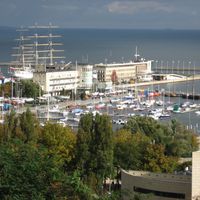City center
6.17

Overview
Gdynia Śródmieście is the central, seaside district of the city, which developed mainly in the 1920s and 1930s. It is characterized by modernist architecture designed by renowned architects, including Włodzimierz Prochaska and Tadeusz Jędrzejewski. The buildings here survived World War II in good condition, which contributed to the urban layout of Śródmieście being entered into the register of monuments in 2007 and placed on the list of historic monuments in 2015. The district borders Oksywie, Obłuże, Pogórze, Chylonia, Leszczynki, Grabówek, Działki Leśne, Wzgórze Świętego Maksymiliana, Kamienna Góra, and the Baltic Sea. Śródmieście is home to many important institutions, such as the Gdynia City Hall, the District Court Building, and the Emigration Museum, as well as historic sites like Gdynia Główna Railway Station and residential buildings. It is worth mentioning the modernist urban layout, which in 2019 earned a spot on the UNESCO tentative list. Śródmieście is also a cultural hub, hosting various events and home to the Musical Theatre. The district features popular tourist attractions such as the Southern Pier, the Gdynia Aquarium, the Dar Pomorza, and the ORP Błyskawica. In 2019, the region's first woonerf was introduced, and as part of the KLIMATyczne Centrum project, new green areas and restrictions on car traffic are planned. An interesting fact is that during the German occupation, Śródmieście was called Stadtmitte, and after the war, the port area was incorporated into the district. The history of the area is rich, with intriguing stories of the heirs of pre-war owners and plans that were either realized or not, such as the construction of the Forum Kultury. Gdynia Śródmieście is a place that combines rich history, dynamic development, and a modern approach to urban space.
Location
Tickets
Powered by GetYourGuide
You can also find here:

ORP Lightning
8.33
City center, Gdynia

Pomerania Gift
7.49
City center, Gdynia

Gdynia Aquarium
7.19
City center, Gdynia

The Collegiate Basilica of the Most Holy Virgin Mary, Queen of Poland in Gdynia
7.01
City center, Gdynia

Emigration Museum in Gdynia
6.55
City center, Gdynia

Gdynia Maritime Station
6.39
City center, Gdynia

Gdynia Główna
6.21
City center, Gdynia

Naval Shipyard
6.02
City center, Gdynia
2025 Wizytor | All Rights Reserved